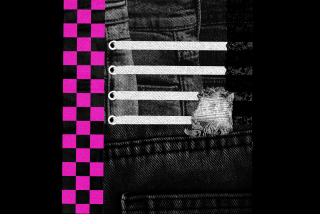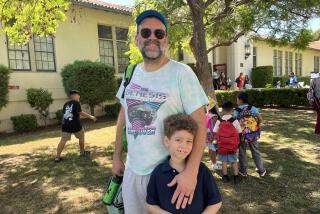Getting ‘freaky’ middle school students into a new groove
- Share via
A middle school in Sunland is combating a trend toward sexually suggestive dancing by offering its students an alternative: lessons in more appropriate ways to move on the dance floor.
The salacious dance style is called “freaking,” “grinding” or “the nasty.” The moves, with their pelvic thrusts and intimate positions, are familiar to many students through hip-hop music videos.
Lately, freaking has gained popularity among pre-teens.
Administrators have said it’s more suited to a strip club than a school gym.
At a Halloween dance this year at Mt. Gleason Middle School in Sunland, a small enclave in the northeast San Fernando Valley, chaperons reacted with dismay as 11-, 12- and 13-year-olds crammed into the center of the room and freak-danced to R&B; singer Akon’s “Smack That.”
History teacher Wende Mintz hasn’t chaperoned a school dance since last year’s holiday party.
“When I saw them freak dancing, I had to leave,” she said.
Teachers told the students at the Halloween dance to stop, and even threw some out of the building.
But as the DJ fielded requests for hip-hop, pop and reggaeton music, the reason for the freaking became clear: students didn’t know how else to dance.
High schools across the nation have been trying to curb the freaking trend in recent years, instituting restrictions or bans. But the topic has largely avoided discussion at middle schools.
Principal Charles Salter of Aliso Niguel High School in Aliso Viejo brought attention to the trend when he banned school dances in September because of widespread freaking. The ban was lifted after almost three months, but only after students and parents signed a contract with strict guidelines forbidding front-to-back dancing and excessive touching and requiring students to keep both feet on the floor.
Marley Chung, a shop teacher and student government sponsor at Mt. Gleason, observed the same problem and pitched a solution to her fourth-period leadership class.
“We’re hoping that maybe by exposing you to other forms of dance, you will dance a little less freak-like,” she said.
She arranged for the school to hire a local instructor to teach the students socially acceptable moves in lieu of their annual holiday dance.
Students were upset that their dance had been “canceled.” Teachers saw it as a proactive measure.
Encouraging more modest ways to dance is as important as telling students how not to dance, said Assistant Principal Tom Adams.
“Instead of telling kids ‘You can’t do this’ or ‘You can’t do that,’ we’re giving them an alternative,” Chung said.
Middle-schoolers acknowledge that friends, older siblings, and above all, music videos, influence their dancing.
“Three letters: MTV,” said seventh-grader Allison Seiler, 12, a recently reformed freaker.
“I used to do it before it became a big problem,” she said. “I have to say that at the Halloween dance I was freaking. I got yelled at.”
At the after-school dance class Thursday, dance instructor Tobie Columbus demonstrated the basic steps for swing.
“Step, touch, step, touch,” she called out.
Boy-girl pairs avoided eye contact as they formed two lines that stretched most of the length of the bare-floored auditorium.
The students mimicked Columbus’ steps, many with hands in their pockets and arms crossed.
Several boys paired off with each other, too embarrassed by the formal dance style to approach girls.
Later, they learned the foxtrot to “Bossy,” a hip-hop song by Kelis.
“You can’t ask the kids to do an old dance to old music,” Columbus said. “These dances can be as contemporary as when they were first created.”
The foxtrot dates to 1914, when Vaudeville actor Harry Fox developed the rectangular box-step motion to go with ragtime music. In its early days, ragtime was associated with brothels and spurned by polite society.
Columbus, who works for the McGroarty Arts Center in Tujunga, will make the dance classes a regular school activity. Starting in February, a group of 12 to 15 students will study social dance twice a week at no cost to them or the school.
About 50 students attended the optional after-school activity; teachers and administrators had hoped for more.
Seventh-grader Chris Safi, 12, was considering learning the steps, but resigned himself to sitting with curiosity on a table in the back “watching other people mess up.”
“I didn’t want to do it because slow dancing is boring,” he said. “When we dance we’re active and like to express who we are.”
Seventh-grader David Gonzalez, 13, spent the hour-long class dancing with sixth-grader Joy Bridges, his left hand tucked under his armpit.
“I never even thought about this kind of dancing before,” he said.
Adams, the assistant principal, envisions school dances where DJs would play music to inspire a variety of dances, from reggaeton to the foxtrot.
“We’re not going to get them all,” he said. “At first it’s going to seem strange. A lot of kids are going to sit out on those songs.”
Seventh-grader Ashley McClure, 12, was dubious: “You can’t waltz to hip-hop.”
*
More to Read
Sign up for Essential California
The most important California stories and recommendations in your inbox every morning.
You may occasionally receive promotional content from the Los Angeles Times.














